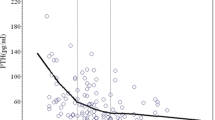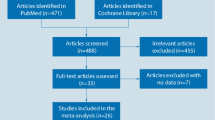Abstract
Background
Vitamin D insufficiency contributes to muscle weakness and a higher risk of falls in older adults.
Objectives
This study explored the impact of vitamin D supplementation on self-reported falls and physical function in older adults with low vitamin D levels and a recent fall history.
Materials and Methods
Twenty-five older adults ≥ 70 years with two or more falls during the past year, low vitamin D blood levels (≥10 ng/ml and < 30 ng/mL), and slow gait speed (1.2 m/s) participated in a 6-month vitamin D supplementation (800 IU/day) study. A modified version of the Morse Fall Scale questionnaire was used to assess frequency of falls over one-year prior to study enrollment. Functional outcomes (short physical performance battery, handgrip strength, gait Timed Up and Go, and six-minute walk), and vitamin D levels were assessed at baseline and 6-month follow-up.
Results
Based on diaries and pill counts, participants were generally adherent to the intervention (6 of 7 days per week). Supplementation with 800 IU/day of vitamin D for 6 months increased blood vitamin D levels from 23.25±4.8 ng/ml to 29.13±6.9 ng/ml (p<0.001). Self-reported number of falls decreased from an average of 3.76 ± 2.2 falls in one-year to 0.76 ± 1.4 falls (p <0.0001) over the 6-month intervention. No changes in functional outcome measures were observed.
Conclusions
Vitamin D supplementation at the currently recommended dose of 800 IU/day increased blood vitamin D levels and reduced frequency of falls in older adults with low vitamin D levels and a recent fall history.



Similar content being viewed by others
References
Wilhelm-Leen, E.R., et al., Vitamin D deficiency and frailty in older Americans. J Intern Med, 2010. 268(2): p. 171–80.
Sherman, F.T., Vitamin D deficiency is rampant in older adults. Geriatrics, 2008. 63(4): p. 9–11.
Dharmarajan, T.S., et al., Vitamin D deficiency in community older adults with falls of gait imbalance: an under-recognized problem in the inner city. J Nutr Elder, 2005. 25(1): p. 7–19.
Gloth, F.M., 3rd and J.D. Tobin, Vitamin D deficiency in older people. J Am Geriatr Soc, 1995. 43(7): p. 822–8.
Forrest, K.Y. and W.L. Stuhldreher, Prevalence and correlates of vitamin D deficiency in US adults. Nutr Res, 2011. 31(1): p. 48–54.
Cranney, A., et al., Effectiveness and safety of vitamin D in relation to bone health. Evid Rep Technol Assess (Full Rep), 2007(158): p. 1–235.
Holick, M.F., High prevalence of vitamin D inadequacy and implications for health. Mayo Clin Proc, 2006. 81(3): p. 353–73.
Bischoff-Ferrari, H.A., et al., Estimation of optimal serum concentrations of 25-hydroxyvitamin D for multiple health outcomes. Am J Clin Nutr, 2006. 84(1): p. 18–28.
Malabanan, A., I.E. Veronikis, and M.F. Holick, Redefining vitamin D insufficiency. Lancet, 1998. 351(9105): p. 805–6.
Chapuy, M.C., et al., Prevalence of vitamin D insufficiency in an adult normal population. Osteoporos Int, 1997. 7(5): p. 439–43.
Zamboni, M., et al., Relation between vitamin D, physical performance, and disability in elderly persons. J Gerontol A Biol Sci Med Sci, 2002. 57(1): p. M7–11.
Pfeifer, M., et al., Vitamin D status, trunk muscle strength, body sway, falls, and fractures among 237 postmenopausal women with osteoporosis. Exp Clin Endocrinol Diabetes, 2001. 109(2): p. 87–92.
Gale, C.R., C. Cooper, and A. Aihie Sayer, Prevalence and risk factors for falls in older men and women: The English Longitudinal Study of Ageing. Age Ageing, 2016. 45(6): p. 789–794.
Manoy, P., et al., Vitamin D Supplementation Improves Quality of Life and Physical Performance in Osteoarthritis Patients. Nutrients, 2017. 9(8).
Levis, S. and O. Gomez-Marin, Vitamin D and Physical Function in Sedentary Older Men. J Am Geriatr Soc, 2017. 65(2): p. 323–331.
Janssen, H.C., M.M. Samson, and H.J. Verhaar, Muscle strength and mobility in vitamin D-insufficient female geriatric patients: a randomized controlled trial on vitamin D and calcium supplementation. Aging Clin Exp Res, 2010. 22(1): p. 78–84.
Prince, R.L., et al., Effects of ergocalciferol added to calcium on the risk of falls in elderly high-risk women. Arch Intern Med, 2008. 168(1): p. 103–8.
Pramyothin, P. and M.F. Holick, Vitamin D supplementation: guidelines and evidence for subclinical deficiency. Curr Opin Gastroenterol, 2012. 28(2): p. 139–50.
Rubenstein, L.Z. and K.R. Josephson, Falls and their prevention in elderly people: what does the evidence show? Med Clin North Am, 2006. 90(5): p. 807–24.
Fernando, E., et al., Risk Factors Associated with Falls in Older Adults with Dementia: A Systematic Review. Physiother Can, 2017. 69(2): p. 161–170.
Pangman, V.C., J. Sloan, and L. Guse, An examination of psychometric properties of the mini-mental state examination and the standardized mini-mental state examination: implications for clinical practice. Appl Nurs Res, 2000. 13(4): p. 209–13.
Morse, J.M., et al., A prospective study to identify the fall-prone patient. Soc Sci Med, 1989. 28(1): p. 81–6.
Morse JM, M.R., Tylko S., Development of a scale to identify the fall-prone patient. Canadian Journal on Aging, 1989. 8(4): p. 366–377.
Podsiadlo, D. and S. Richardson, The timed «Up & Go»: a test of basic functional mobility for frail elderly persons. J Am Geriatr Soc, 1991. 39(2): p. 142–8.
Guralnik, J.M., et al., Lower extremity function and subsequent disability: consistency across studies, predictive models, and value of gait speed alone compared with the short physical performance battery. J Gerontol A Biol Sci Med Sci, 2000. 55(4): p. M221–31.
Jin, H., Y. Kim, and S.J. Rhie, Factors affecting medication adherence in elderly people. Patient Prefer Adherence, 2016. 10: p. 2117–2125.
Neiman, A.B., et al., CDC Grand Rounds: Improving Medication Adherence for Chronic Disease Management — Innovations and Opportunities. MMWR Morb Mortal Wkly Rep, 2017. 66(45): p. 1248–1251.
Bosworth, H.B., et al., Medication adherence: a call for action. Am Heart J, 2011. 162(3): p. 412–24.
Murad, M.H., et al., Clinical review: The effect of vitamin D on falls: a systematic review and meta-analysis. J Clin Endocrinol Metab, 2011. 96(10): p. 2997–3006.
Flicker, L., et al., Should older people in residential care receive vitamin D to prevent falls? Results of a randomized trial. J Am Geriatr Soc, 2005. 53(11): p. 1881–8.
Pfeifer, M., et al., Effects of a long-term vitamin D and calcium supplementation on falls and parameters of muscle function in community-dwelling older individuals. Osteoporos Int, 2009. 20(2): p. 315–22.
Bischoff, H.A., et al., In situ detection of 1,25-dihydroxyvitamin D3 receptor in human skeletal muscle tissue. Histochem J, 2001. 33(1): p. 19–24.
Akdeniz, S., et al., The relation between vitamin D and postural balance according to clinical tests and tetrax posturography. J Phys Ther Sci, 2016. 28(4): p. 1272–7.
Christakos, S., et al., Vitamin D and the intestine: Review and update. J Steroid Biochem Mol Biol, 2020. 196: p. 105501.
Chanet, A., et al., Vitamin D supplementation restores the blunted muscle protein synthesis response in deficient old rats through an impact on ectopic fat deposition. J Nutr Biochem, 2017. 46: p. 30–38.
Romeu Montenegro, K., et al., Effects of vitamin D on primary human skeletal muscle cell proliferation, differentiation, protein synthesis and bioenergetics. J Steroid Biochem Mol Biol, 2019. 193: p. 105423.
Curry, O.B., et al., Calcium uptake by sarcoplasmic reticulum of muscle from vitamin D-deficient rabbits. Nature, 1974. 249(452): p. 83–4.
Dzik, K.P. and J.J. Kaczor, Mechanisms of vitamin D on skeletal muscle function: oxidative stress, energy metabolism and anabolic state. Eur J Appl Physiol, 2019. 119(4): p. 825–839.
Rejnmark, L., Effects of vitamin d on muscle function and performance: a review of evidence from randomized controlled trials. Ther Adv Chronic Dis, 2011. 2(1): p. 25–37.
Kiraly, S.J., et al., Vitamin D as a neuroactive substance: review. ScientificWorldJournal, 2006. 6: p. 125–39.
Ceglia, L., et al., A randomized study on the effect of vitamin D(3) supplementation on skeletal muscle morphology and vitamin D receptor concentration in older women. J Clin Endocrinol Metab, 2013. 98(12): p. E1927–35.
Bischoff, H.A., et al., Effects of vitamin D and calcium supplementation on falls: a randomized controlled trial. J Bone Miner Res, 2003. 18(2): p. 343–51.
Brunner, R.L., et al., Calcium, vitamin D supplementation, and physical function in the Women’s Health Initiative. J Am Diet Assoc, 2008. 108(9): p. 1472–9.
Armbrecht, H.J., et al., Effect of age on intestinal calcium absorption and adaptation to dietary calcium. The American journal of physiology, 1979. 236(6): p. E769–E774.
Lapid, M.I., S.S. Cha, and P.Y. Takahashi, Vitamin D and depression in geriatric primary care patients. Clinical interventions in aging, 2013. 8: p. 509–514.
Laird, E., et al., Vitamin D and bone health: potential mechanisms. Nutrients, 2010. 2(7): p. 693–724.
Kim, M.K., et al., Vitamin D deficiency is associated with sarcopenia in older Koreans, regardless of obesity: the Fourth Korea National Health and Nutrition Examination Surveys (KNHANES IV) 2009. J Clin Endocrinol Metab, 2011. 96(10): p. 3250–6.
Aspray, T.J., et al., National Osteoporosis Society vitamin D guideline summary. Age Ageing, 2014. 43(5): p. 592–5.
American Geriatrics Society Workgroup on Vitamin, D.S.f.O.A., Recommendations abstracted from the American Geriatrics Society Consensus Statement on vitamin D for Prevention of Falls and Their Consequences. J Am Geriatr Soc, 2014. 62(1): p. 147–52.
Teagarden, D.L., K.J. Meador, and D.W. Loring, Low vitamin D levels are common in patients with epilepsy. Epilepsy research, 2014. 108(8): p. 1352–1356.
Roomi, M.A., et al., Hypovitaminosis D and its association with lifestyle factors. Pakistan journal of medical sciences, 2015. 31(5): p. 1236–1240.
Acknowledgments
We would like to thank the participants and the study staff for their efforts in completing this study.
Funding
Funding: This study was supported by 1 P30 AG028740-01.
Author information
Authors and Affiliations
Contributions
Author Contributions: Christiaan Leeuwenburgh, Stephen Anton, conceived and designed the study; Robert Mankowski, Peihua Qiu, and Lu You analyzed the data; Stephen Anton and Robert Mankowski drafted the manuscript; Benjamin Bensadon, Carlo Custodero, Juhan Lee, Christian McLaren, Christiaan Leeuwenburgh and Elizabeth Audino edited the manuscript. Jacobo Hincapie and Shanti Ganesh provided feedback on the manuscript and wrote a clinical perspective section.
Corresponding author
Ethics declarations
Conflicts of Interest: The authors declare no conflict of interest.
Rights and permissions
About this article
Cite this article
Anton, S.D., Mankowski, R.T., Qiu, P. et al. Vitamin D Supplementation Is Associated with a Reduction in Self-Reported Falls among Older Adults with Previous Fall History — Feasibility Study. J Frailty Aging 11, 224–230 (2022). https://doi.org/10.14283/jfa.2021.46
Received:
Accepted:
Published:
Issue Date:
DOI: https://doi.org/10.14283/jfa.2021.46




